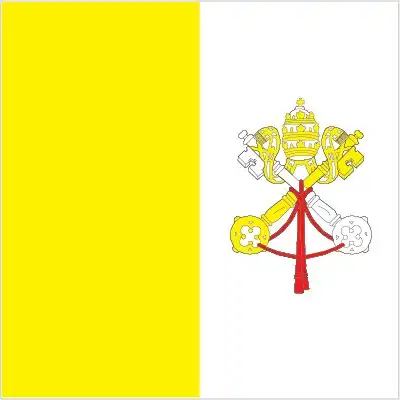Vatican City Flag (the Holy See)
National Flag of Holy See
Vatican City Flag (the Holy See) Display

Quick Facts About Holy See and flag of Holy See
- Adopted:
- Aspect Ratio:
- 1:1 (square)
- Capital:
- Vatican City
- Population:
- Approximately 800 (2023)
Vatican City Flag (the Holy See) - Description
The flag of the Holy See is a vertical bicolor of gold-yellow and white, with the crossed keys of Saint Peter and the papal tiara centered in the white half. The keys symbolize the authority bestowed on Saint Peter and his successors, the popes, while the gold and silver keys represent spiritual and worldly power, and the crossed arrangement reflects the Papacy’s role as guardian of faith and moral authority.
Vatican City Flag (the Holy See) – Symbolism and Meaning
Gold signifies the spiritual power of the Pope, while white symbolizes purity and charitable peace. The crossed keys—one gold and one silver—are the keys to Heaven promised to Saint Peter, signifying the Papacy’s religious authority and spiritual mission. The tiara, featuring three crowns, represents the threefold power of the Pope: father of princes and kings, ruler of the world, and Vicar of Christ.
Vatican City Flag (the Holy See) - History and Origins
Following the Lateran Treaty of 1929 establishing Vatican City as a sovereign entity, the Holy See adopted its flag on 7 June 1929. The colors derive from the keys of Saint Peter, historically gold and silver, and were prescribed in medieval papal iconography. The flag design has remained stable since creation, underscoring the continuity of papal leadership and worldwide representation of the Church.
Vatican City Flag (the Holy See) - Design Elements
The flag is a distinctive square shape. The left half is gold-yellow, and the right half is white. Centered in the white is the iconic papal emblem: crossed keys (one gold, one silver) beneath a triple-tiered papal tiara. The simple two-color field and potent symbolism offer immediate recognition, encapsulating centuries of ecclesiastical authority.
Vatican City Flag (the Holy See) - Usage Guidelines and Protocol
Used extensively within Vatican City, embassies, and at international Catholic gatherings, the Holy See flag must adhere to precise guidelines: it is flown only when the pope is present or for official Church functions. It never serves as a national emblem in a secular sense and is never flown at half-mast except at papal death or extremely solemn liturgical ceremonies. Display is governed by Vatican protocol, ensuring it remains a revered symbol of spiritual unity and papal office.
Frequently Asked Questions
What do the colors of the Vatican City Flag (the Holy See) represent?
Gold signifies the spiritual power of the Pope, while white symbolizes purity and charitable peace. The crossed keys—one gold and one silver—are the keys to Heaven promised to Saint Peter, signifying the Papacy’s religious authority and spiritual mission. The tiara, featuring three crowns, represents the threefold power of the Pope: father of princes and kings, ruler of the world, and Vicar of Christ.
When was the Vatican City Flag (the Holy See) adopted?
The Holy See flag was adopted on 7 June 1929, marking an important milestone in the country's development as an independent nation.
What is the aspect ratio of the Vatican City Flag (the Holy See)?
The Holy See flag has an aspect ratio of 1:1 (square), which determines the proportional relationship between its width and height for official display purposes.